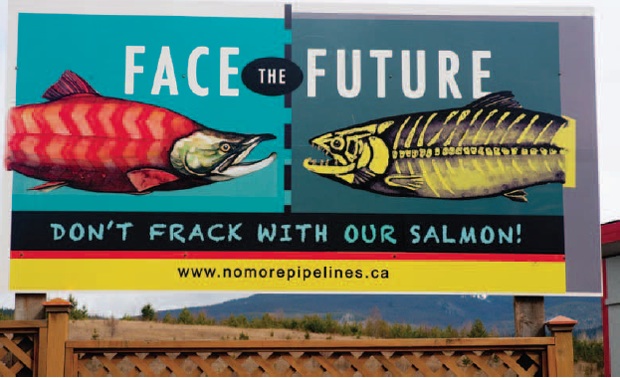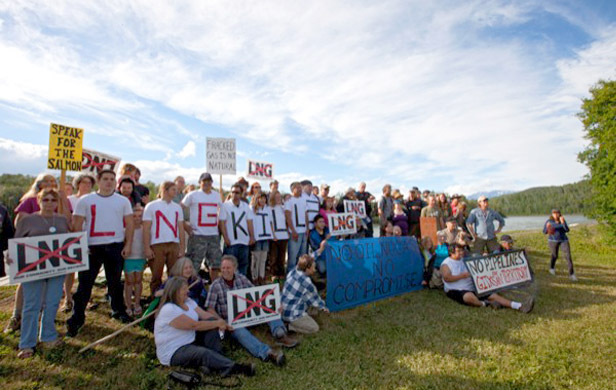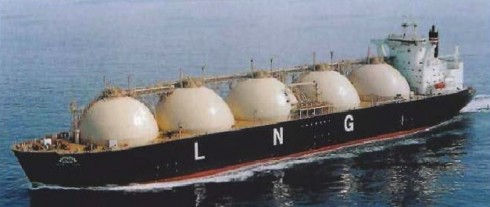The fight against fracking, fracked gas pipelines and LNG terminals is heating up in B.C. Resistance is on the rise — communities across B.C. are mobilizing to take a stand against a fractured future and oppose Premier Clark’s dangerous and dirty LNG pipedreams.
Liquefied natural gas, also known as LNG, is anything but natural. It is fracked gas that has to be turned into liquid by super cooling the gas to -163 C so it can be exported via some of the largest tankers in the world. There are upwards of six northern and six southern corridor pipelines proposed to connect the fracked gas fields of the northeast to the proposed LNG export terminals and tankers on the west coast. At some point in the future, these fracked gas pipelines could be converted to carry oil. Click here to view map of the many proposed pipelines and LNG terminals.
The combined impacts from fracking, fracked gas pipeline construction, gas liquefaction and export make LNG a major contributor to global climate change. The gas boom in British Columbia could result in an additional 73 million tons of greenhouse gas emissions per year, which would amount to about the same as Alberta’s tar sands as early as 2020. Considering that 14 LNG projects have been proposed for B.C., five of those terminals alone would more than double B.C.’s current climate footprint. The emissions from the 12 LNG terminals proposed for Prince Rupert and Kitimat would bring acid rain and serious air pollution to the region and impact the health of residents and surrounding ecology. A few of these LNG plants will produce the same amount of emissions as the entire city of Vancouver.
Fracking has devastating impacts on local watersheds and ecosystems. More than 600 chemicals have been used in fracking, and many of these chemicals have been linked to cancer, mutations, and impacts to the nervous, immune, and cardiovascular systems. Assuming that nine of 10 proposed wells were fracked, about 582 billion litres of water would be contaminated. The Fort Nelson First Nation has stated that fracking on their territories represents “the largest and most destructive industrial force that our waters have ever known.” The boom in proposed Liquefied Natural Gas (LNG) developments could result in a 600 per cent increase in fracking on their already heavily impacted territory. Concerns over water withdrawals and cumulative impacts on Treaty 8 territory have been ignored by the B.C. government, which continues to approve fracking projects at a breakneck pace.

Lelu Island and Ridley Island near Prince Rupert are both being considered as locations for LNG terminals. The area where these terminals are proposed has been found to have the highest abundance of some of the most important salmon species within the Skeena watershed — one of the last places on earth with healthy populations of wild salmon and the second largest run in Canada. Findings from a recent study by scientists at Simon Fraser University show that Pacific Northwest LNG and Prince Rupert LNG are right in the most sensitive spot for millions of Skeena salmon. If granted environmental licenses, both LNG projects would dredge hundreds of thousands of cubic metres of underwater sediment to construct berths for 500 LNG carrier tankers to port each year. SFU scientists cautioned that the destruction from their construction and operation could be the tipping point for Skeena salmon — one they may never recover from it. Click here to check out a video for more information.
The targeted gutting of key legislation in B.C. has also paved the way for pipeline and LNG development. The B.C. government recently passed Bill 4, the Park Amendment Act, a highly opposed bill that will open protected park areas to pipelines and drilling. The government is also trying to pass Bill 24, which would decimate the Agricultural Land Reserve (ALR) and open up good farmland to allow for industrial development, such as fracking, pipelines and the diversion of water for oil and gas.
Opposition to fracking and LNG is growing
At an LNG industry summit hosted by the Fort Nelson First Nation in April, Fort Nelson Chief Sharleen Gailordered B.C. government officials and industry to exit the conference in reaction to a surprise move by the B.C. government to gut environmental reviews for gas plants without consulting First Nations. The B.C. government quickly reversed the decision. “The Fort Nelson First Nation, on behalf of our ancestors, our elders, our youth and those yet to come are putting the government and the oil and gas industry on notice that B.C.’s LNG Strategy is on hold,” said Chief Gale at the Summit.

In northwestern B.C., the fracked gas pipelines would have to pass through the unceded territories of the Wet’suwet’en and Gitxsan First Nations. The Uni’stoten clan of the Wet’suwet’en vow to maintain their active long-standing blockade against the Pacific Trails (PTP) fracked gas pipeline, and other major pipelines that would cross their territory. Over the last four years, the Unist’ot’en have occupied the right of way of the PTP and Enbridge pipelines, and evicted the companies from conducting activities on their territory. Freda Huson, spokeswoman for the Unist’ot’en Clan, states:
“Pacific Trails Pipeline does not have permission to be on our territory. This is unceded land. Pacific Trail Pipeline’s proposed route is through two main salmon spawning channels which provide our staple food supply. We have made the message clear to Pacific Trails, Enbridge, and all of industry: We will not permit any pipelines through our territory.”
In the path of these pipelines, the Unist’ot’en have built a cabin, a traditional pithouse, permaculture gardens and a bunkhouse for blockaders. You can donate to their resistance by clicking here.

Some Gitxsan Hereditary Chiefs and communities are expressing concern as several fracked gas pipelines are being proposed through their territories as well. On Aug. 26, 2014, Luutkudziiwus, Xsim Wits’iin and Noola, Gitxsan hereditary chiefs, on behalf of their house members declared their Madii Lii territory permanently closed to all natural gas pipeline development, and began construction of a long-term base camp to focus on various territory management initiatives. The cease and desist notification is addressed to the B.C. government and TransCanada Corporation in regard to the Madii Lii territory, located in the Suskwa valley, and pertains specifically to TransCanada’s plans for the Prince Rupert Gas Transmission (PRGT) fracked gas pipeline project. The proposed PRGT will cross Madii Lii territory for about 32 km. The fracked gas pipeline will be supplying the proposed Lelu Island LNG plant in Skeena estuary, where substantial impacts are predicted to negatively affect juvenile salmon.
Their spokesperson, Richard Wright, had this to say: “On behalf of our House Group, Norm, Les and Charlie are putting the Government on notice that the proposed LNG pipeline will not be going though our territory. We are implementing our Territorial Management Plan. This starts with building a long term base camp at the beginning of our territory.” Click here to check out a video of their cabin building!
In Hazelton and the Kispiox Valley, concerned residents are organizing. A significant proportion of the Kispiox Valley’s local population, where the Spectra and TransCanada fracked pipelines are being proposed, signed onto the Kispiox Declaration against the LNG projects proposed through the community. “It’s boom and bust on steroids, like we’ve never seen here before,” says Todd Stockner, a fishing guide in the Kispiox.
“There will be some local jobs, but it’s only for 2-5 years at most and then it’s gone. And then what do we have after that? We have all the risk. We have all the lingering damages done to our rivers and streams, we have whatever nightmare of social problems that come with three 1,000-person workcamps dropped into a valley of 240 people. What we have here now is an economy that is enduring, resilient, it’s been here for a long time and a lot of it is based around the rivers and small-scale forestry. That’s renewable. These things create jobs. A wild salmon economy in the Skeena Watershed creates $110 million/year, and that could be happening every year as long as we take care of it, which these projects are not going to do.”
At a recent TransCanada open house in Hazelton, community members challenged the slick corporate process and staged a direct action. Click here to watch the video of their action and Transcanada’s response.

What few folks know is that besides being a proposed throughfare for fracked gas pipelines, that area also sits atop what is known as the Bowser Basin — which companies are eyeing for fracking. In Transcanada’s fracked gas pipeline proposal, they mention that they may want to later develop “midstream resources” — likely meaning that at some point fracking in the area could become a reality (as some companies have mentioned before that they are being held back from “developing” these resources because of the lack of pipeline infrastructure). Scary stuff for the mighty Skeena and Kispiox rivers and their salmon runs that nourish whole communities.
Closer to Vancouver, the proposed Woodfibre LNG terminal in Howe Sound and Squamish is being met by resistance from local residents who have raised concerns about the impacts a spill would have on their growing tourism industry. “At a local level, we’re looking at potential air pollution, light and noise pollution, and impacts to marine species due to underwater noise pollution. The community is very concerned about the safety of this proposed LNG facility, and the possibility of explosions and spills,” states Tracey Saxby, one of the founders of My Sea to Sky, a Squamish community group. Howe Sound, after decades of abuse, has finally started to recover — the herring are coming back, the salmon have increased, Orcas abound and humpback whales have appeared for the first time in years. Can Howe Sound survive an LNG project and super tankers? For more information on the impacts and risks of the Woodfibre LNG project, please watch this informative video by Eoin Finn of The Future of Howe Sound and My Sea to Sky.
Several nearby municipal councils, like Gibsons, West Vancouver, Lions Bay and the Sunshine Coast Regional District, recently passed resolutions or wrote letters against either the Woodfibre LNG or LNG tankers in Howe Sound. LNG terminals have also been proposed for Delta, Campbell River and the West Coast of Vancouver Island.

At the recent LNG counter summit in Vancouver, Grand Chief Stewart Phillip from the Union of BC Indian Chiefs had this to say: “It never occurred to me that LNG is far worse then Enbridge and Kinder Morgan. I think we have been lulled into thinking that if we win those battles we have won the war, but I would suggest based on what we witnessed that the LNG is the real enemy and everything that it represents.” He later added: “The economy of this province is being built on the destruction of the NE. And the pipelines that are being contemplated by LNG will further destroy the north. We have a social responsibility as human beings, as grandparents and parents to lend our support to Treaty 8, to all the people in the north who are fighting so valiantly to push back this agenda.”
Wherever you live in B.C., fracking and LNG will impact your community. From the northeast corner to the NW coast and its mighty salmon rivers and wild coast, to Vancouver, Squamish and Vancouver Island, it’s time to step up, get organized, stand in solidarity and support the communities on the frontlines of resistance. Let’s send a clear and unified message to Premier Clark, the B.C. government and Industry: No Fracking, No Pipelines, No LNG!
Check out the following websites for more information:
http://commonsensecanadian.ca/category/energy-2/lng/
http://skeenawatershed.com/projects/detail/lng_in_the_skeena_watershed_think_again
And finally, here are some great videos from the Council of Canadians LNG Countersummit in Vancouver this May:
– UBCIC Grand Chief Stewart Phillip
– Treaty 8 Tribal Chief Liz Logan
– Shannon McPhail (Skeena Watershed Conservation Coalition)
– Joyce Williams (Skwomesh Action)



